child seat MERCEDES-BENZ M-Class 2015 W166 Owner's Manual
[x] Cancel search | Manufacturer: MERCEDES-BENZ, Model Year: 2015, Model line: M-Class, Model: MERCEDES-BENZ M-Class 2015 W166Pages: 466, PDF Size: 8.92 MB
Page 9 of 466
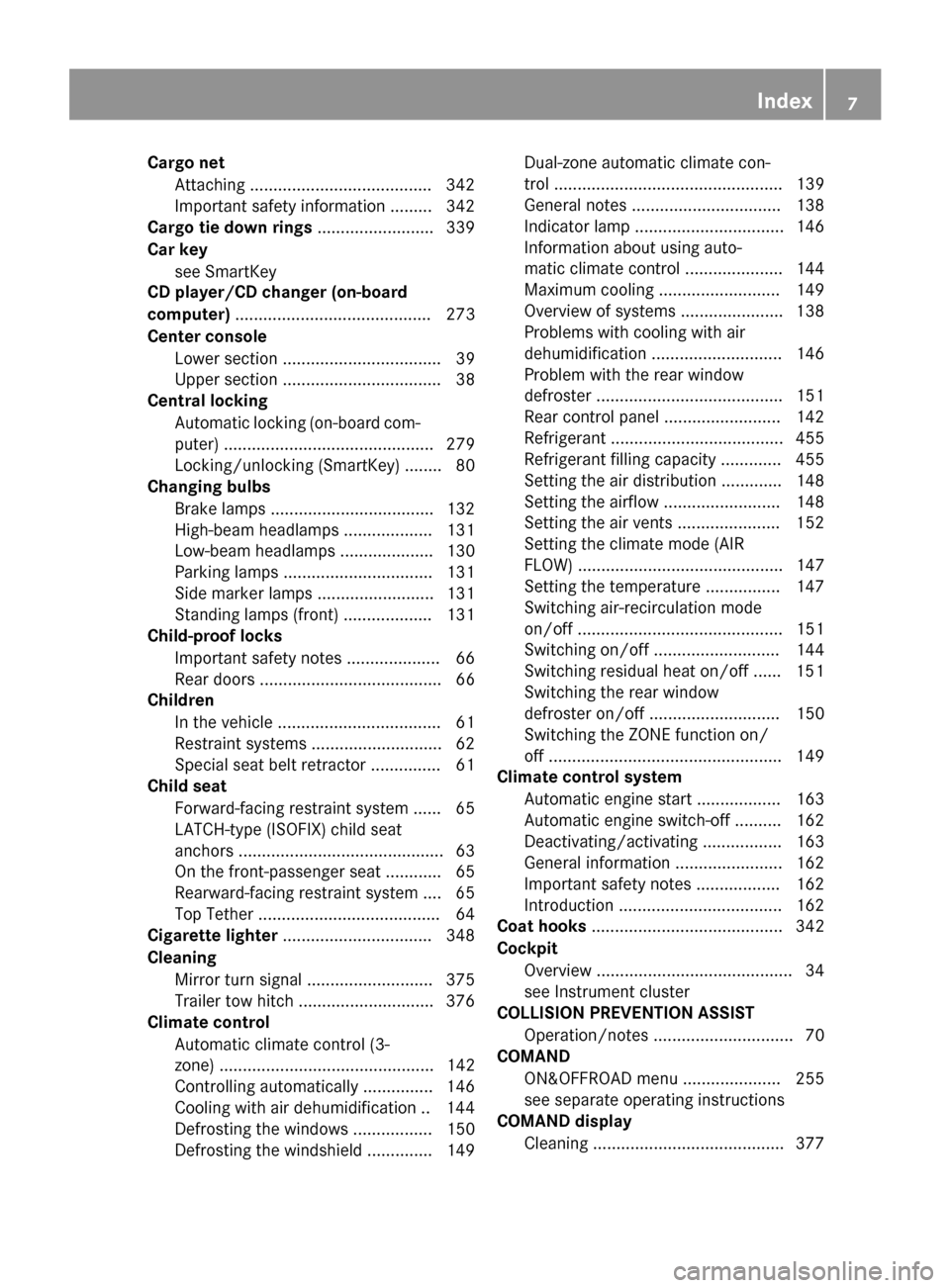
Cargo net
Attaching ...................................... .342
Important safety information ......... 342
Cargo tie down rings ......................... 339
Car key see SmartKey
CD player/CD changer (on-board
computer) .......................................... 273
Center console Lower section .................................. 39
Upper section .................................. 38
Central locking
Automatic locking (on-board com-
puter) ............................................. 279
Locking/unlocking (SmartKey) ....... .80
Changing bulbs
Brake lamps .................................. .132
High-beam headlamps ................... 131
Low-beam headlamps .................... 130
Parking lamps ................................ 131
Side marker lamps ......................... 131
Standing lamps (front) ................... 131
Child-proof locks
Important safety notes .................... 66
Rear doors ....................................... 66
Children
In the vehicle ................................... 61
Restraint systems ............................ 62
Special seat belt retractor .............. .61
Child seat
Forward-facing restraint system ...... 65
LATCH-type (ISOFIX) child seat
anchors ............................................ 63
On the front-passenger seat ............ 65
Rearward-facing restraint system .... 65
Top Tether ...................................... .64
Cigarette lighter ................................ 348
Cleaning Mirror turn signal .......................... .375
Trailer tow hitch ............................ .376
Climate control
Automatic climate control (3-
zone) .............................................. 142
Controlling automatically .............. .146
Cooling with air dehumidification .. 144
Defrosting the windows ................. 150
Defrosting the windshield .............. 149 Dual-zone automatic climate con-
trol ................................................. 139
General notes ................................ 138
Indicator lamp ................................ 146
Information about using auto-
matic climate control ..................... 144
Maximum cooling .......................... 149
Overview of systems ..................... .138
Problems with cooling with air
dehumidification ............................ 146
Problem with the rear window
defroster ........................................ 151
Rear control panel ......................... 142
Refrigerant ..................................... 455
Refrigerant filling capacity ............. 455
Setting the air distribution ............. 148
Setting the airflow ......................... 148
Setting the air vents ..................... .152
Setting the climate mode (AIR
FLOW) ............................................ 147
Setting the temperature ................ 147
Switching air-recirculation mode
on/off ............................................ 151
Switching on/off ........................... 144
Switching residual heat on/off ...... 151
Switching the rear window
defroster on/off ............................ 150
Switching the ZONE function on/
off ................................................. .149
Climate control system
Automatic engine start .................. 163
Automatic engine switch-off .......... 162
Deactivating/activating ................. 163
General information ....................... 162
Important safety notes .................. 162
Introduction ................................... 162
Coat hooks ......................................... 342
Cockpit Overview .......................................... 34
see Instrument cluster
COLLISION PREVENTION ASSIST
Operation/notes .............................. 70
COMAND
ON&OFFROAD menu ..................... 255
see separate operating instructions
COMAND display
Cleaning ......................................... 377 Index
7
Page 15 of 466
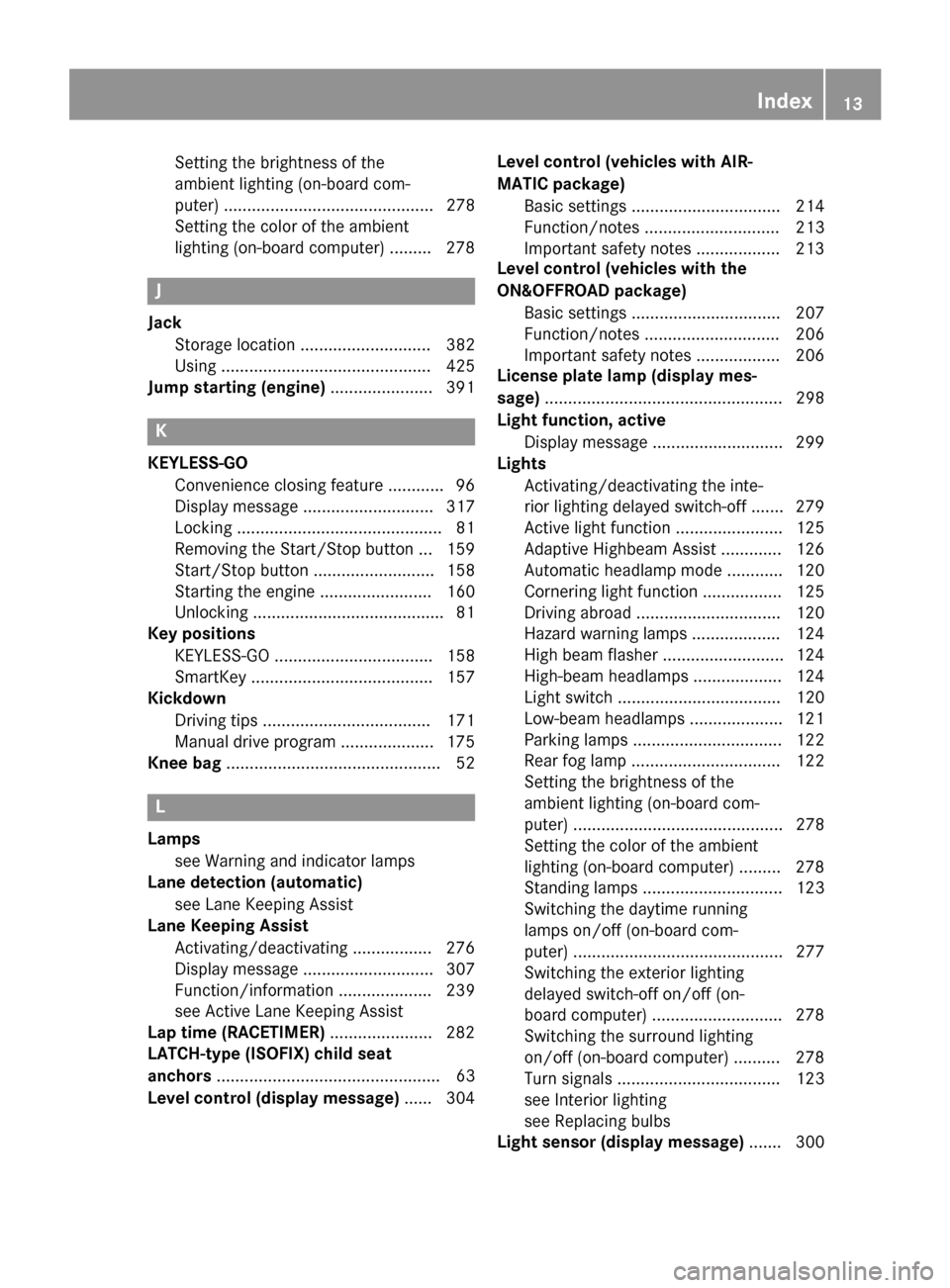
Setting the brightness of the
ambient lighting (on-board com-
puter) ............................................. 278
Setting the color of the ambient
lighting (on-board computer) ......... 278
J
Jack Storage location ............................ 382
Using ............................................. 425
Jump starting (engine) ...................... 391K
KEYLESS-GO Convenience closing feature ............ 96
Display message ............................ 317
Locking ............................................ 81
Removing the Start/Stop button ... 159
Start/Stop button .......................... 158
Starting the engine ........................ 160
Unlocking ......................................... 81
Key positions
KEYLESS-GO .................................. 158
SmartKey ....................................... 157
Kickdown
Driving tips .................................... 171
Manual drive progra m.................... 175
Knee bag .............................................. 52 L
Lamps see Warning and indicator lamps
Lane detection (automatic)
see Lane Keeping Assist
Lane Keeping Assist
Activating/deactivating ................. 276
Display message ............................ 307
Function/information .................... 239
see Active Lane Keeping Assist
Lap time (RACETIMER) ...................... 282
LATCH-type (ISOFIX) child seat
anchors ................................................ 63
Level control (display message) ...... 304Level control (vehicles with AIR-
MATIC package)
Basic settings ................................ 214
Function/note s............................. 213
Important safety notes .................. 213
Level control (vehicles with the
ON&OFFROAD package) Basic settings ................................ 207
Function/note s............................. 206
Important safety notes .................. 206
License plate lamp (display mes-
sage) ................................................... 298
Light function, active Display message ............................ 299
Lights
Activating/deactivating the inte-
rior lighting delayed switch-off ....... 279
Active light function ....................... 125
Adaptive Highbeam Assist ............. 126
Automatic headlamp mod e............ 120
Cornering light function ................. 125
Driving abroad ............................... 120
Hazard warning lamps ................... 124
High beam flashe r.......................... 124
High-beam headlamp s................... 124
Light switch ................................... 120
Low-beam headlamp s.................... 121
Parking lamps ................................ 122
Rear fog lamp ................................ 122
Setting the brightness of the
ambient lighting (on-board com-
puter) ............................................. 278
Setting the color of the ambient
lighting (on-board computer) ......... 278
Standing lamps .............................. 123
Switching the daytime running
lamps on/off (on-board com-
puter) ............................................. 277
Switching the exterior lighting
delayed switch-off on/off (on-
board computer) ............................ 278
Switching the surround lighting
on/off (on-board computer) .......... 278
Turn signals ................................... 123
see Interior lighting
see Replacing bulbs
Light sensor (display message) ....... 300 Index
13
Page 19 of 466
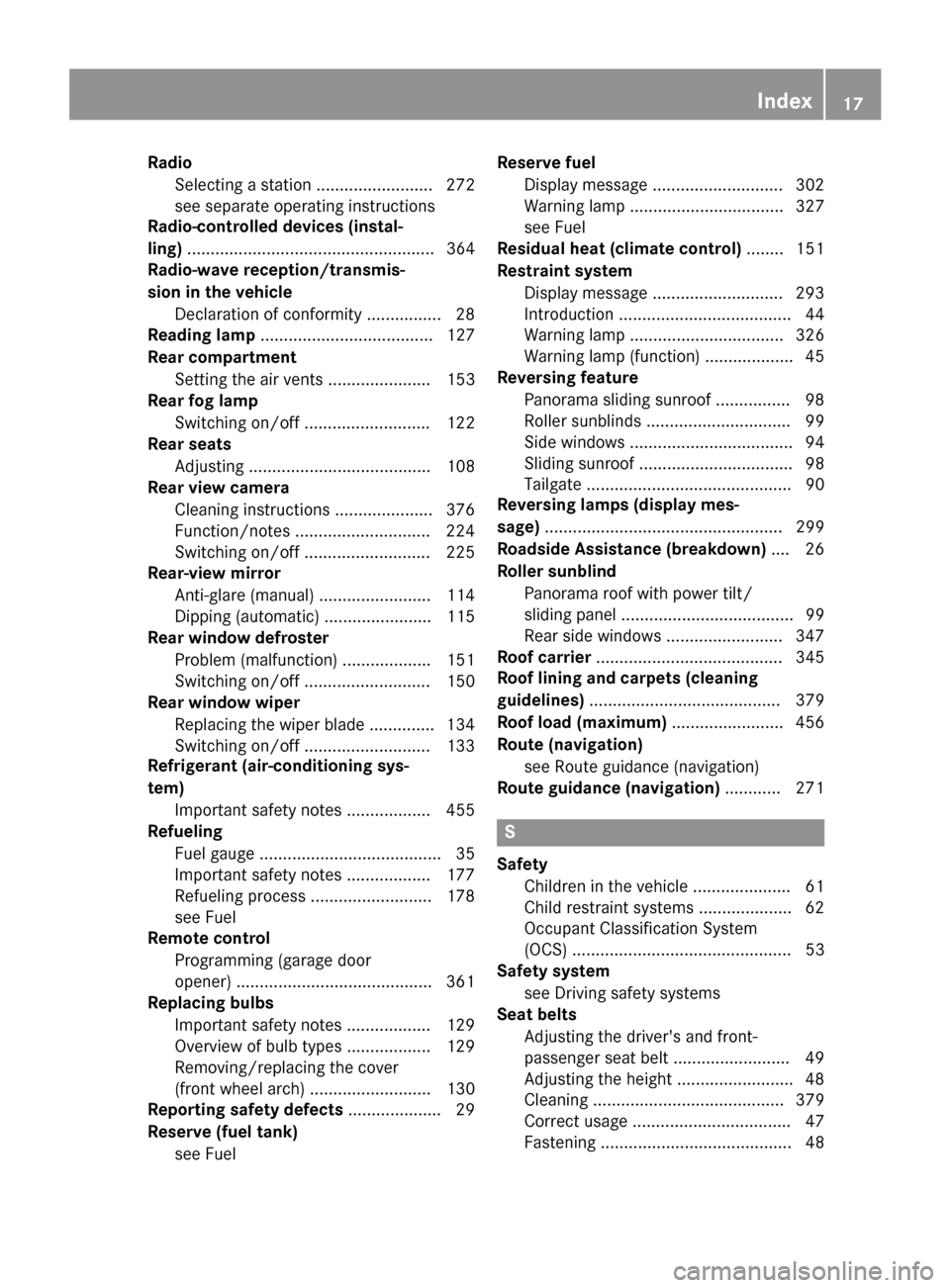
Radio
Selecting a station ......................... 272
see separate operating instructions
Radio-controlled devices (instal-
ling) ..................................................... 364
Radio-wave reception/transmis-
sion in the vehicle Declaration of conformity ................ 28
Reading lamp ..................................... 127
Rear compartment Setting the air vents ...................... 153
Rear fog lamp
Switching on/off ........................... 122
Rear seats
Adjusting ....................................... 108
Rear view camera
Cleaning instructions ..................... 376
Function/notes ............................ .224
Switching on/off ........................... 225
Rear-view mirror
Anti-glare (manual) ........................ 114
Dipping (automatic) ....................... 115
Rear window defroster
Problem (malfunction) ................... 151
Switching on/off ........................... 150
Rear window wiper
Replacing the wiper blade .............. 134
Switching on/off ........................... 133
Refrigerant (air-conditioning sys-
tem)
Important safety notes .................. 455
Refueling
Fuel gauge ....................................... 35
Important safety notes .................. 177
Refueling process .......................... 178
see Fuel
Remote control
Programming (garage door
opener) .......................................... 361
Replacing bulbs
Important safety notes .................. 129
Overview of bulb type s.................. 129
Removing/replacing the cover
(front wheel arch) .......................... 130
Reporting safety defects .................... 29
Reserve (fuel tank) see Fuel Reserve fuel
Display message ............................ 302
Warning lamp ................................. 327
see Fuel
Residual heat (climate control) ........ 151
Restraint system Display message ............................ 293
Introduction ..................................... 44
Warning lamp ................................. 326
Warning lamp (function) ................... 45
Reversing feature
Panorama sliding sunroo f................ 98
Roller sunblind s............................... 99
Side windows ................................... 94
Sliding sunroof ................................. 98
Tailgate ............................................ 90
Reversing lamps (display mes-
sage) ................................................... 299
Roadside Assistance (breakdown) .... 26
Roller sunblind Panorama roof with power tilt/
sliding panel ..................................... 99
Rear side window s......................... 347
Roof carrier ........................................ 345
Roof lining and carpets (cleaning
guidelines) ......................................... 379
Roof load (maximum) ........................ 456
Route (navigation) see Route guidance (navigation)
Route guidance (navigation) ............ 271 S
Safety Children in the vehicle ..................... 61
Child restraint systems .................... 62
Occupant Classification System
(OCS) ............................................... 53
Safety system
see Driving safety systems
Seat belts
Adjusting the driver's and front-
passenger seat belt ......................... 49
Adjusting the height ......................... 48
Cleaning ......................................... 379
Correct usage .................................. 47
Fastening ......................................... 48 Index
17
Page 46 of 466
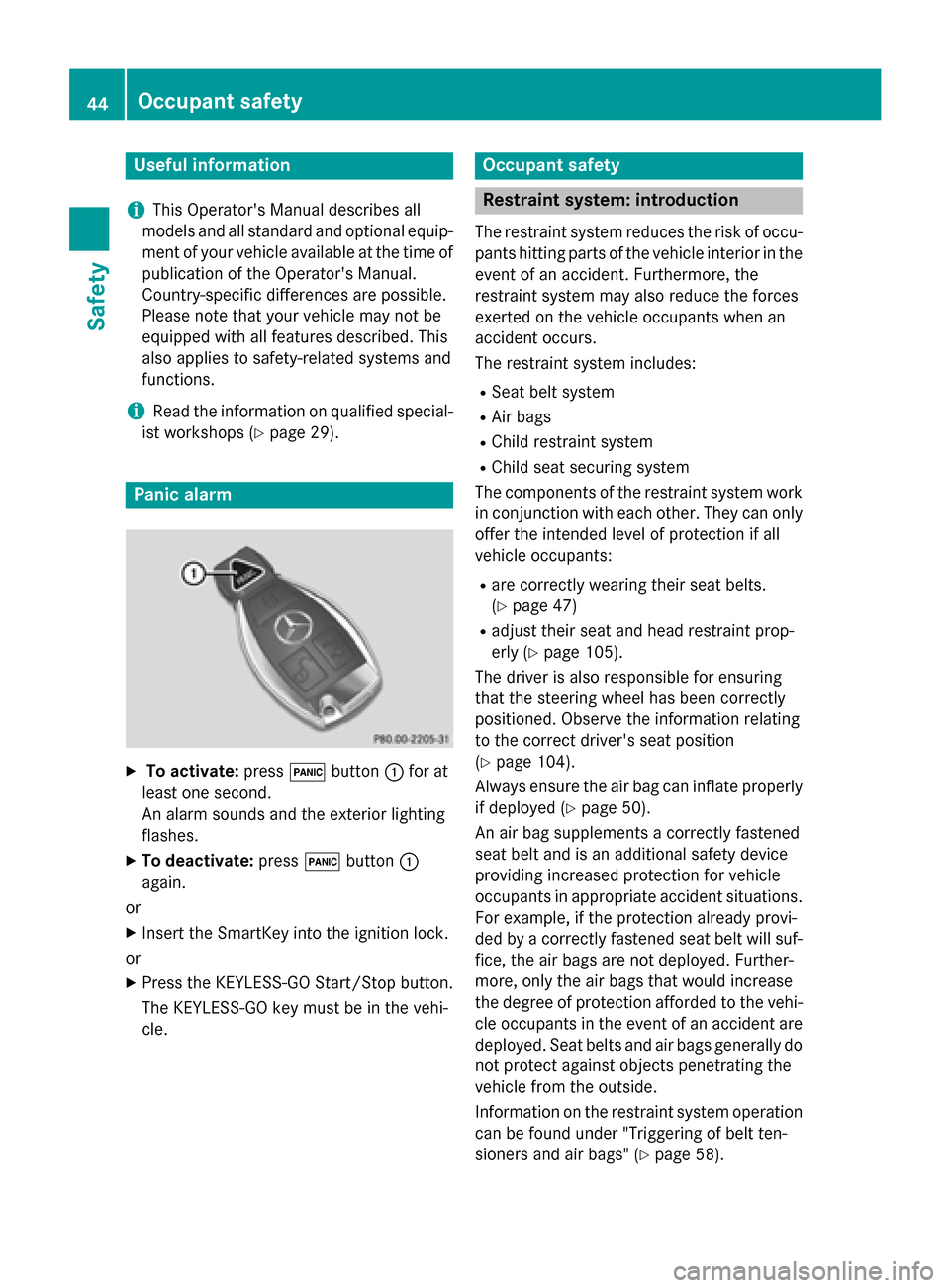
Useful information
i This Operator's Manual describes all
models and all standard and optional equip- ment of your vehicle available at the time of
publication of the Operator's Manual.
Country-specific differences are possible.
Please note that your vehicle may not be
equipped with all features described. This
also applies to safety-related systems and
functions.
i Read the information on qualified special-
ist workshops (Y page 29). Panic alarm
X
To activate: press0033button 0043for at
least one second.
An alarm sounds and the exterior lighting
flashes.
X To deactivate: press0033button 0043
again.
or
X Insert the SmartKey into the ignition lock.
or X Press the KEYLESS-GO Start/Stop button.
The KEYLESS-GO key must be in the vehi-
cle. Occupant safety
Restraint system: introduction
The restraint system reduces the risk of occu-
pants hitting parts of the vehicle interior in the
event of an accident. Furthermore, the
restraint system may also reduce the forces
exerted on the vehicle occupants when an
accident occurs.
The restraint system includes:
R Seat belt system
R Air bags
R Child restraint system
R Child seat securing system
The components of the restraint system work
in conjunction with each other. They can only
offer the intended level of protection if all
vehicle occupants:
R are correctly wearing their seat belts.
(Y page 47)
R adjust their seat and head restraint prop-
erly (Y page 105).
The driver is also responsible for ensuring
that the steering wheel has been correctly
positioned. Observe the information relating
to the correct driver's seat position
(Y page 104).
Always ensure the air bag can inflate properly if deployed (Y page 50).
An air bag supplements a correctly fastened
seat belt and is an additional safety device
providing increased protection for vehicle
occupants in appropriate accident situations.
For example, if the protection already provi-
ded by a correctly fastened seat belt will suf-
fice, the air bags are not deployed. Further-
more, only the air bags that would increase
the degree of protection afforded to the vehi- cle occupants in the event of an accident are deployed. Seat belts and air bags generally do
not protect against objects penetrating the
vehicle from the outside.
Information on the restraint system operation can be found under "Triggering of belt ten-
sioners and air bags" (Y page 58).44
Occupant safetySafety
Page 48 of 466
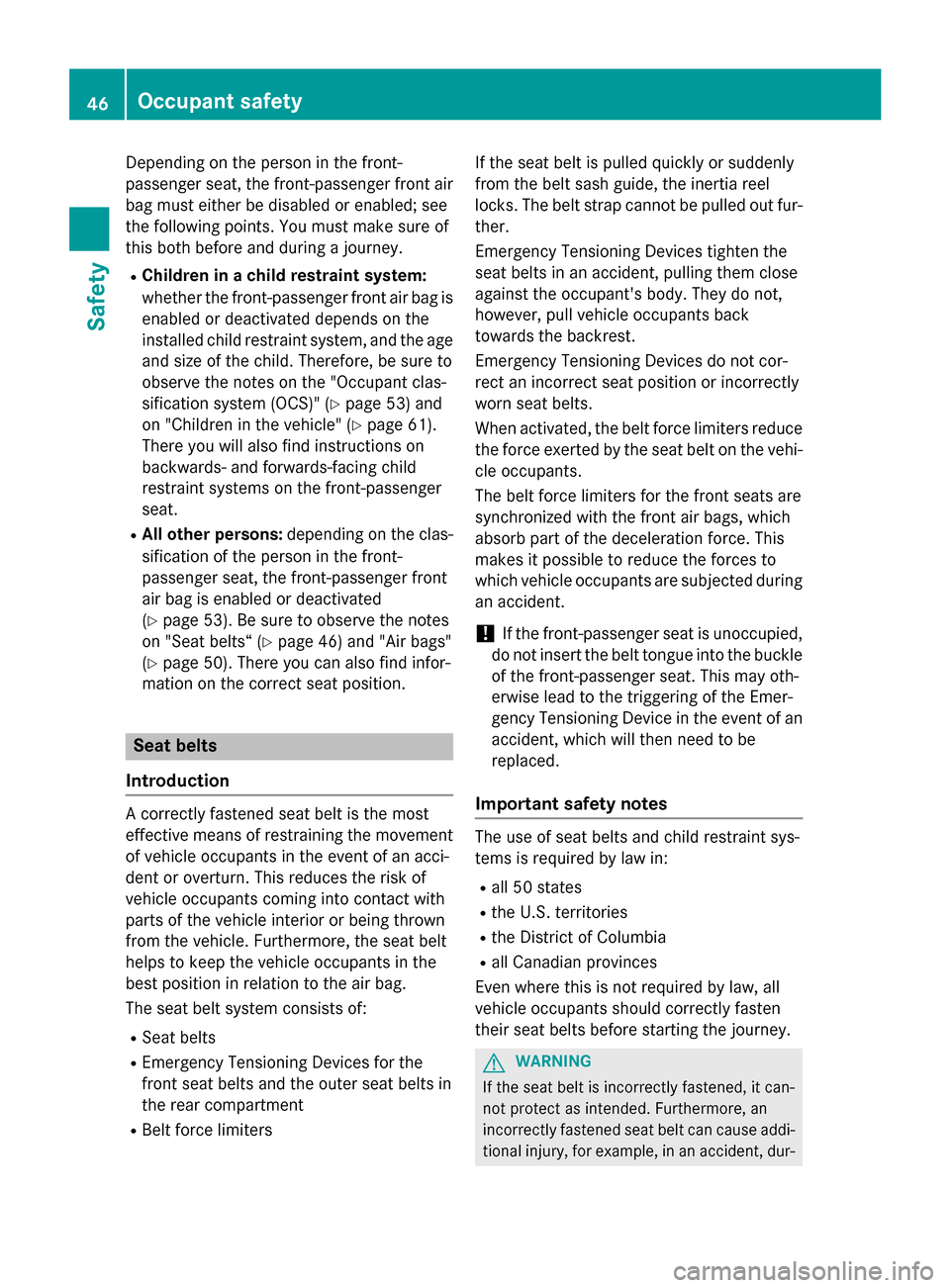
Depending on the person in the front-
passenger seat, the front-passenger front air
bag must either be disabled or enabled; see
the following points. You must make sure of
this both before and during a journey.
R Children in a child restraint system:
whether the front-passenger front air bag is
enabled or deactivated depends on the
installed child restraint system, and the age
and size of the child. Therefore, be sure to
observe the notes on the "Occupant clas-
sification system (OCS)" (Y page 53) and
on "Children in the vehicle" (Y page 61).
There you will also find instructions on
backwards- and forwards-facing child
restraint systems on the front-passenger
seat.
R All other persons: depending on the clas-
sification of the person in the front-
passenger seat, the front-passenger front
air bag is enabled or deactivated
(Y page 53). Be sure to observe the notes
on "Seat belts“ (Y page 46) and "Air bags"
(Y page 50). There you can also find infor-
mation on the correct seat position. Seat belts
Introduction A correctly fastened seat belt is the most
effective means of restraining the movement
of vehicle occupants in the event of an acci-
dent or overturn. This reduces the risk of
vehicle occupants coming into contact with
parts of the vehicle interior or being thrown
from the vehicle. Furthermore, the seat belt
helps to keep the vehicle occupants in the
best position in relation to the air bag.
The seat belt system consists of:
R Seat belts
R Emergency Tensioning Devices for the
front seat belts and the outer seat belts in
the rear compartment
R Belt force limiters If the seat belt is pulled quickly or suddenly
from the belt sash guide, the inertia reel
locks. The belt strap cannot be pulled out fur-
ther.
Emergency Tensioning Devices tighten the
seat belts in an accident, pulling them close
against the occupant's body. They do not,
however, pull vehicle occupants back
towards the backrest.
Emergency Tensioning Devices do not cor-
rect an incorrect seat position or incorrectly
worn seat belts.
When activated, the belt force limiters reduce
the force exerted by the seat belt on the vehi-
cle occupants.
The belt force limiters for the front seats are
synchronized with the front air bags, which
absorb part of the deceleration force. This
makes it possible to reduce the forces to
which vehicle occupants are subjected during an accident.
! If the front-passenger seat is unoccupied,
do not insert the belt tongue into the buckle of the front-passenger seat. This may oth-
erwise lead to the triggering of the Emer-
gency Tensioning Device in the event of anaccident, which will then need to be
replaced.
Important safety notes The use of seat belts and child restraint sys-
tems is required by law in:
R all 50 states
R the U.S. territories
R the District of Columbia
R all Canadian provinces
Even where this is not required by law, all
vehicle occupants should correctly fasten
their seat belts before starting the journey. G
WARNING
If the seat belt is incorrectly fastened, it can-
not protect as intended. Furthermore, an
incorrectly fastened seat belt can cause addi- tional injury, for example, in an accident, dur- 46
Occupant safetySafety
Page 49 of 466
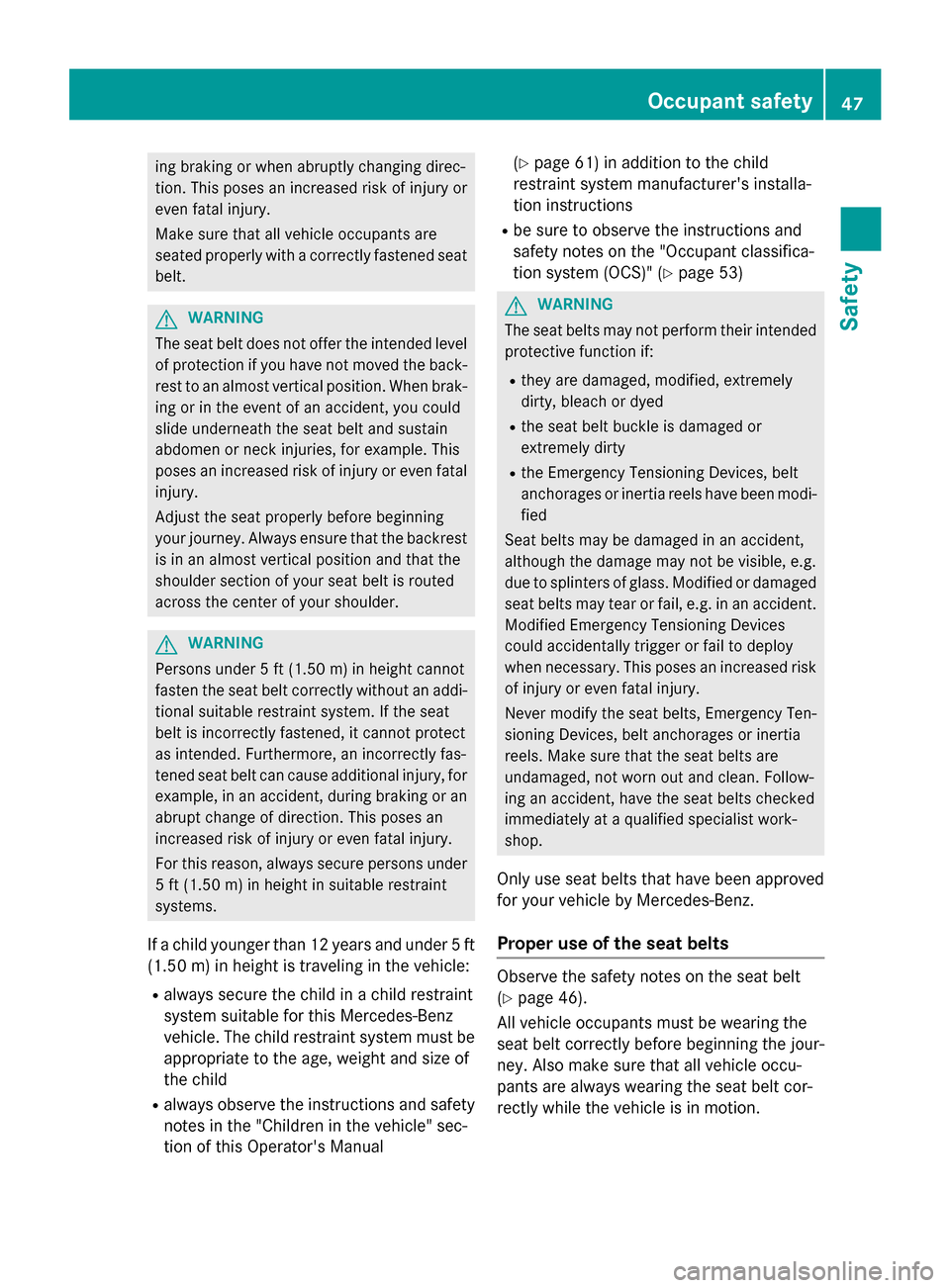
ing braking or when abruptly changing direc-
tion. This poses an increased risk of injury or
even fatal injury.
Make sure that all vehicle occupants are
seated properly with a correctly fastened seat belt. G
WARNING
The seat belt does not offer the intended level of protection if you have not moved the back-
rest to an almost vertical position. When brak-
ing or in the event of an accident, you could
slide underneath the seat belt and sustain
abdomen or neck injuries, for example. This
poses an increased risk of injury or even fatal injury.
Adjust the seat properly before beginning
your journey. Always ensure that the backrest
is in an almost vertical position and that the
shoulder section of your seat belt is routed
across the center of your shoulder. G
WARNING
Persons under 5 ft (1.50 m) in height cannot
fasten the seat belt correctly without an addi- tional suitable restraint system. If the seat
belt is incorrectly fastened, it cannot protect
as intended. Furthermore, an incorrectly fas-
tened seat belt can cause additional injury, for
example, in an accident, during braking or an
abrupt change of direction. This poses an
increased risk of injury or even fatal injury.
For this reason, always secure persons under
5 ft (1.50 m) in height in suitable restraint
systems.
If a child younger than 12 years and under 5 ft
(1.50 m) in height is traveling in the vehicle:
R always secure the child in a child restraint
system suitable for this Mercedes-Benz
vehicle. The child restraint system must be
appropriate to the age, weight and size of
the child
R always observe the instructions and safety
notes in the "Children in the vehicle" sec-
tion of this Operator's Manual (Y
page 61) in addition to the child
restraint system manufacturer's installa-
tion instructions
R be sure to observe the instructions and
safety notes on the "Occupant classifica-
tion system (OCS)" (Y page 53) G
WARNING
The seat belts may not perform their intended protective function if:
R they are damaged, modified, extremely
dirty, bleach or dyed
R the seat belt buckle is damaged or
extremely dirty
R the Emergency Tensioning Devices, belt
anchorages or inertia reels have been modi-
fied
Seat belts may be damaged in an accident,
although the damage may not be visible, e.g.
due to splinters of glass. Modified or damaged
seat belts may tear or fail, e.g. in an accident. Modified Emergency Tensioning Devices
could accidentally trigger or fail to deploy
when necessary. This poses an increased risk
of injury or even fatal injury.
Never modify the seat belts, Emergency Ten-
sioning Devices, belt anchorages or inertia
reels. Make sure that the seat belts are
undamaged, not worn out and clean. Follow-
ing an accident, have the seat belts checked
immediately at a qualified specialist work-
shop.
Only use seat belts that have been approved
for your vehicle by Mercedes-Benz.
Proper use of the seat belts Observe the safety notes on the seat belt
(Y
page 46).
All vehicle occupants must be wearing the
seat belt correctly before beginning the jour- ney. Also make sure that all vehicle occu-
pants are always wearing the seat belt cor-
rectly while the vehicle is in motion. Occupant safety
47Safety Z
Page 50 of 466
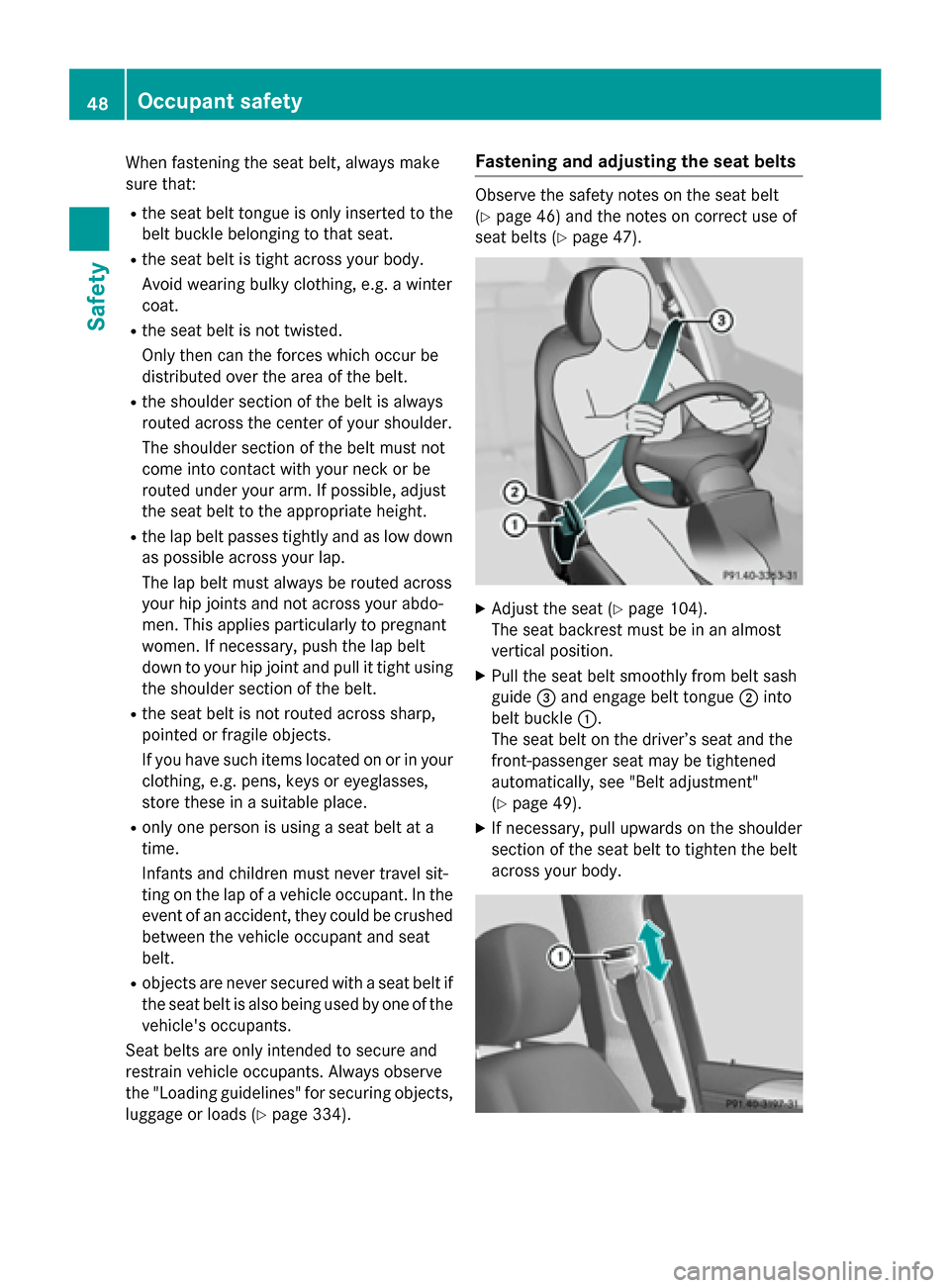
When fastening the seat belt, always make
sure that:
R the seat belt tongue is only inserted to the
belt buckle belonging to that seat.
R the seat belt is tight across your body.
Avoid wearing bulky clothing, e.g. a winter
coat.
R the seat belt is not twisted.
Only then can the forces which occur be
distributed over the area of the belt.
R the shoulder section of the belt is always
routed across the center of your shoulder.
The shoulder section of the belt must not
come into contact with your neck or be
routed under your arm. If possible, adjust
the seat belt to the appropriate height.
R the lap belt passes tightly and as low down
as possible across your lap.
The lap belt must always be routed across
your hip joints and not across your abdo-
men. This applies particularly to pregnant
women. If necessary, push the lap belt
down to your hip joint and pull it tight using
the shoulder section of the belt.
R the seat belt is not routed across sharp,
pointed or fragile objects.
If you have such items located on or in your
clothing, e.g. pens, keys or eyeglasses,
store these in a suitable place.
R only one person is using a seat belt at a
time.
Infants and children must never travel sit-
ting on the lap of a vehicle occupant. In the
event of an accident, they could be crushed
between the vehicle occupant and seat
belt.
R objects are never secured with a seat belt if
the seat belt is also being used by one of the
vehicle's occupants.
Seat belts are only intended to secure and
restrain vehicle occupants. Always observe
the "Loading guidelines" for securing objects,
luggage or loads (Y page 334). Fastening and adjusting the seat belts Observe the safety notes on the seat belt
(Y
page 46) and the notes on correct use of
seat belts (Y page 47). X
Adjust the seat (Y page 104).
The seat backrest must be in an almost
vertical position.
X Pull the seat belt smoothly from belt sash
guide 0087and engage belt tongue 0044into
belt buckle 0043.
The seat belt on the driver’s seat and the
front-passenger seat may be tightened
automatically, see "Belt adjustment"
(Y page 49).
X If necessary, pull upwards on the shoulder
section of the seat belt to tighten the belt
across your body. 48
Occupant safetySafety
Page 51 of 466
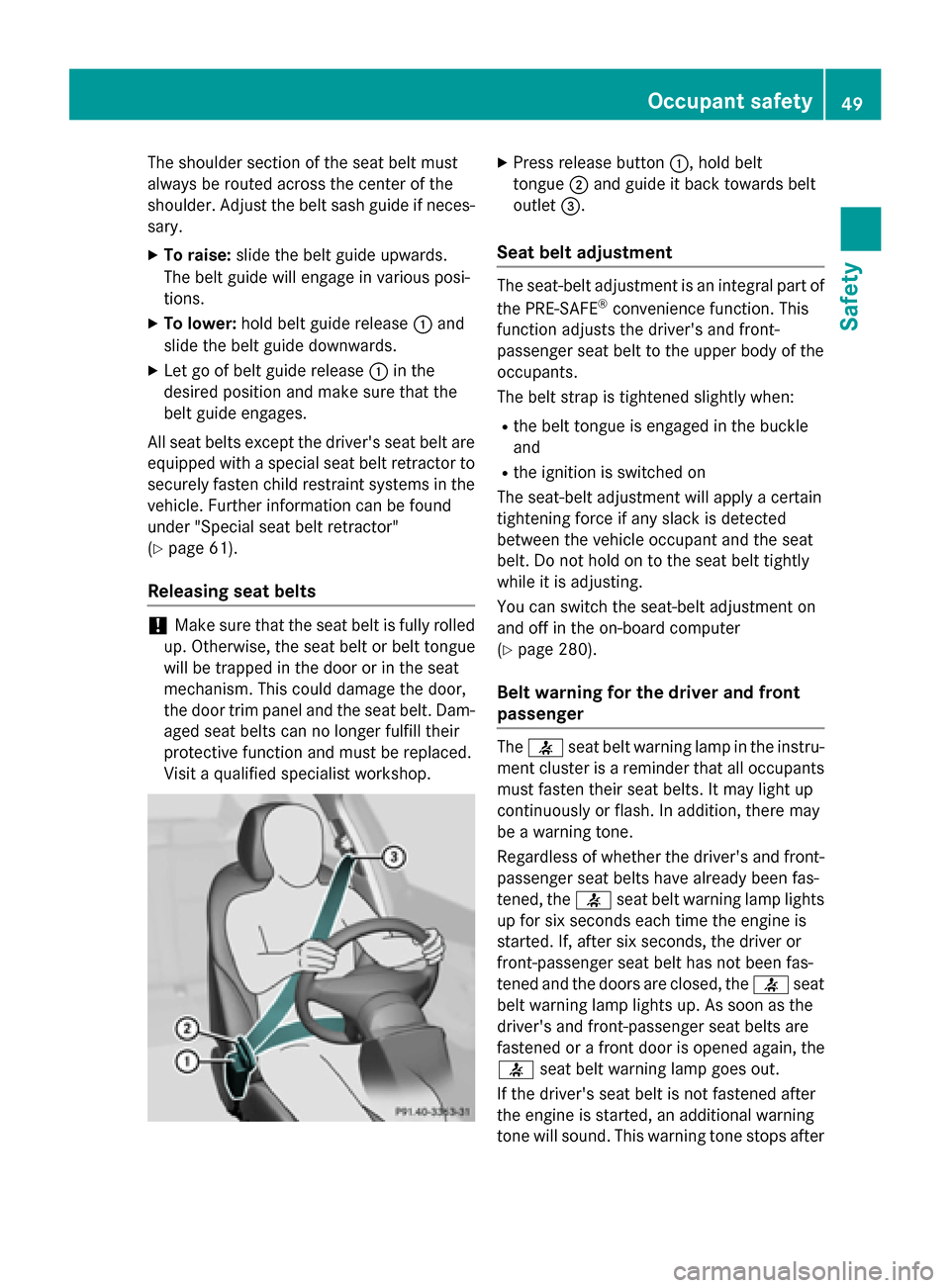
The shoulder section of the seat belt must
always be routed across the center of the
shoulder. Adjust the belt sash guide if neces-
sary.
X To raise: slide the belt guide upwards.
The belt guide will engage in various posi-
tions.
X To lower: hold belt guide release 0043and
slide the belt guide downwards.
X Let go of belt guide release 0043in the
desired position and make sure that the
belt guide engages.
All seat belts except the driver's seat belt are equipped with a special seat belt retractor to
securely fasten child restraint systems in the
vehicle. Further information can be found
under "Special seat belt retractor"
(Y page 61).
Releasing seat belts !
Make sure that the seat belt is fully rolled
up. Otherwise, the seat belt or belt tongue
will be trapped in the door or in the seat
mechanism. This could damage the door,
the door trim panel and the seat belt. Dam-
aged seat belts can no longer fulfill their
protective function and must be replaced.
Visit a qualified specialist workshop. X
Press release button 0043, hold belt
tongue 0044and guide it back towards belt
outlet 0087.
Seat belt adjustment The seat-belt adjustment is an integral part of
the PRE-SAFE ®
convenience function. This
function adjusts the driver's and front-
passenger seat belt to the upper body of the
occupants.
The belt strap is tightened slightly when:
R the belt tongue is engaged in the buckle
and
R the ignition is switched on
The seat-belt adjustment will apply a certain
tightening force if any slack is detected
between the vehicle occupant and the seat
belt. Do not hold on to the seat belt tightly
while it is adjusting.
You can switch the seat-belt adjustment on
and off in the on-board computer
(Y page 280).
Belt warning for the driver and front
passenger The
0076 seat belt warning lamp in the instru-
ment cluster is a reminder that all occupants
must fasten their seat belts. It may light up
continuously or flash. In addition, there may
be a warning tone.
Regardless of whether the driver's and front- passenger seat belts have already been fas-
tened, the 0076seat belt warning lamp lights
up for six seconds each time the engine is
started. If, after six seconds, the driver or
front-passenger seat belt has not been fas-
tened and the doors are closed, the 0076seat
belt warning lamp lights up. As soon as the
driver's and front-passenger seat belts are
fastened or a front door is opened again, the
0076 seat belt warning lamp goes out.
If the driver's seat belt is not fastened after
the engine is started, an additional warning
tone will sound. This warning tone stops after Occupant safety
49Safety Z
Page 52 of 466
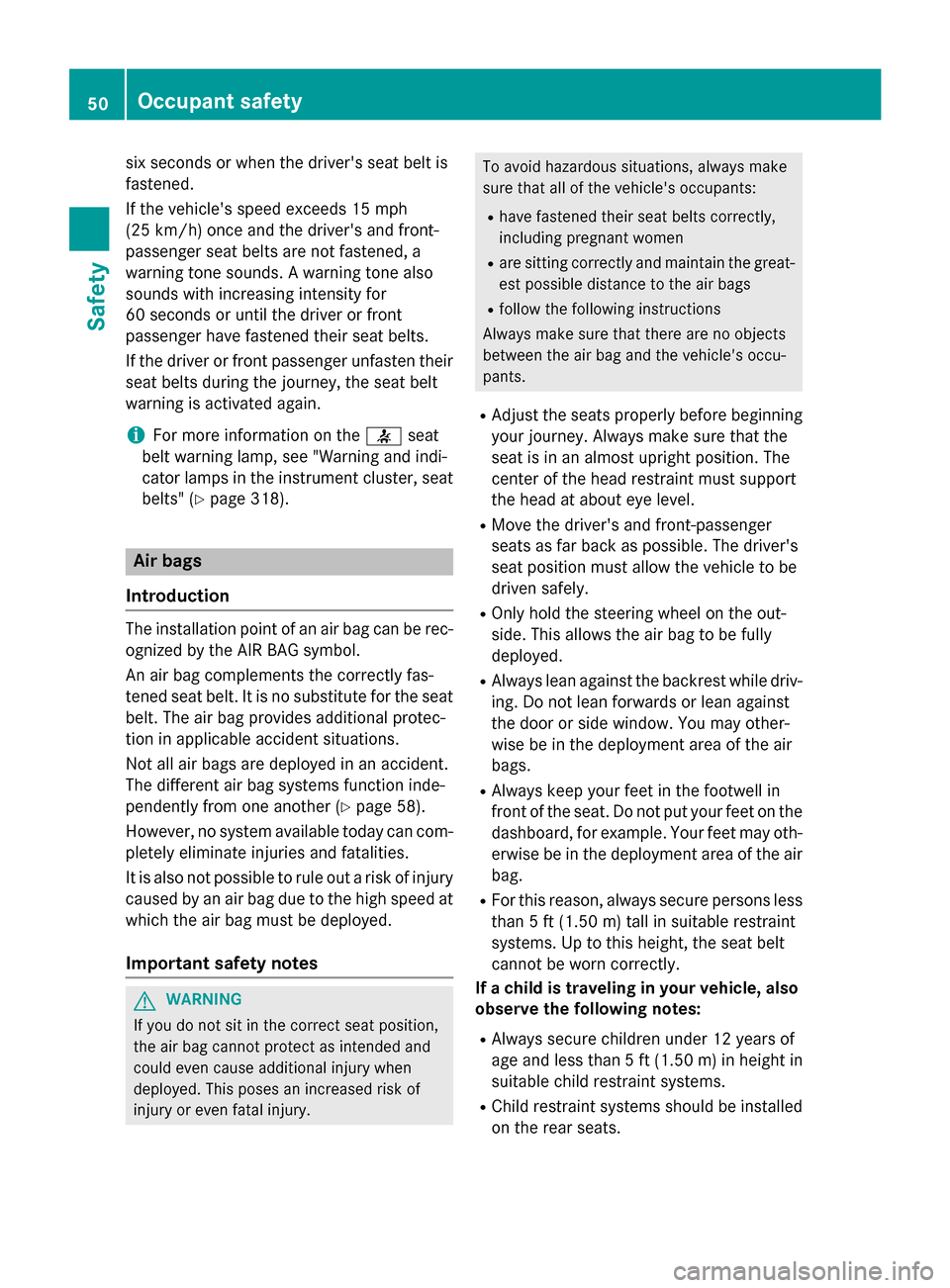
six seconds or when the driver's seat belt is
fastened.
If the vehicle's speed exceeds 15 mph
(25 km/h) once and the driver's and front-
passenger seat belts are not fastened, a
warning tone sounds. A warning tone also
sounds with increasing intensity for
60 seconds or until the driver or front
passenger have fastened their seat belts.
If the driver or front passenger unfasten their seat belts during the journey, the seat belt
warning is activated again.
i For more information on the
0076seat
belt warning lamp, see "Warning and indi-
cator lamps in the instrument cluster, seat
belts" (Y page 318). Air bags
Introduction The installation point of an air bag can be rec-
ognized by the AIR BAG symbol.
An air bag complements the correctly fas-
tened seat belt. It is no substitute for the seat
belt. The air bag provides additional protec-
tion in applicable accident situations.
Not all air bags are deployed in an accident.
The different air bag systems function inde-
pendently from one another (Y page 58).
However, no system available today can com- pletely eliminate injuries and fatalities.
It is also not possible to rule out a risk of injury
caused by an air bag due to the high speed at which the air bag must be deployed.
Important safety notes G
WARNING
If you do not sit in the correct seat position,
the air bag cannot protect as intended and
could even cause additional injury when
deployed. This poses an increased risk of
injury or even fatal injury. To avoid hazardous situations, always make
sure that all of the vehicle's occupants:
R have fastened their seat belts correctly,
including pregnant women
R are sitting correctly and maintain the great-
est possible distance to the air bags
R follow the following instructions
Always make sure that there are no objects
between the air bag and the vehicle's occu-
pants.
R Adjust the seats properly before beginning
your journey. Always make sure that the
seat is in an almost upright position. The
center of the head restraint must support
the head at about eye level.
R Move the driver's and front-passenger
seats as far back as possible. The driver's
seat position must allow the vehicle to be
driven safely.
R Only hold the steering wheel on the out-
side. This allows the air bag to be fully
deployed.
R Always lean against the backrest while driv-
ing. Do not lean forwards or lean against
the door or side window. You may other-
wise be in the deployment area of the air
bags.
R Always keep your feet in the footwell in
front of the seat. Do not put your feet on the
dashboard, for example. Your feet may oth- erwise be in the deployment area of the air
bag.
R For this reason, always secure persons less
than 5 ft (1.50 m) tall in suitable restraint
systems. Up to this height, the seat belt
cannot be worn correctly.
If a child is traveling in your vehicle, also
observe the following notes:
R Always secure children under 12 years of
age and less than 5 ft (1.50 m)in height in
suitable child restraint systems.
R Child restraint systems should be installed
on the rear seats. 50
Occupant safetySafety
Page 53 of 466
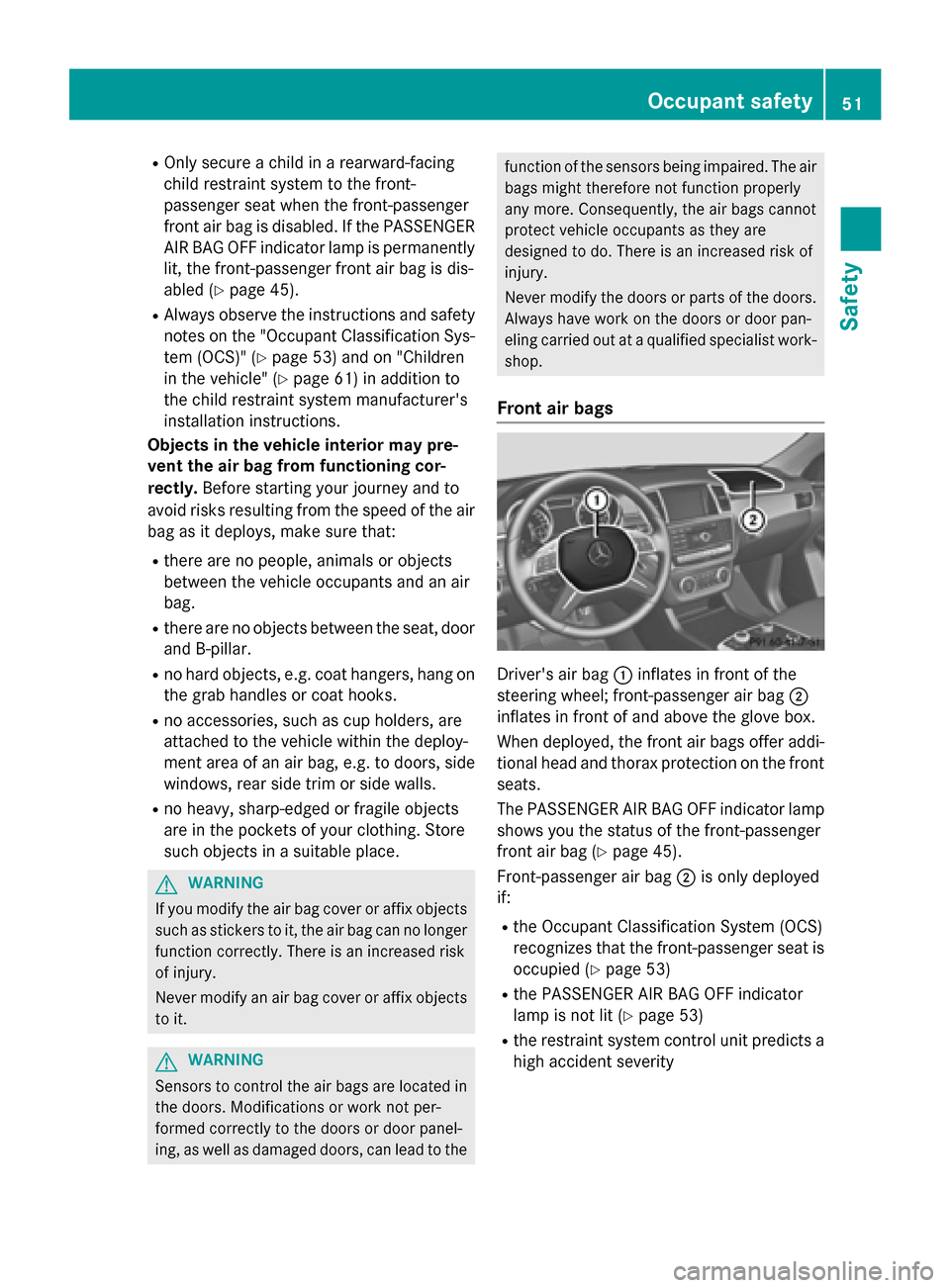
R
Only secure a child in a rearward-facing
child restraint system to the front-
passenger seat when the front-passenger
front air bag is disabled. If the PASSENGER
AIR BAG OFF indicator lamp is permanently
lit, the front-passenger front air bag is dis-
abled (Y page 45).
R Always observe the instructions and safety
notes on the "Occupant Classification Sys-
tem (OCS)" (Y page 53) and on "Children
in the vehicle" (Y page 61) in addition to
the child restraint system manufacturer's
installation instructions.
Objects in the vehicle interior may pre-
vent the air bag from functioning cor-
rectly. Before starting your journey and to
avoid risks resulting from the speed of the air bag as it deploys, make sure that:
R there are no people, animals or objects
between the vehicle occupants and an air
bag.
R there are no objects between the seat, door
and B-pillar.
R no hard objects, e.g. coat hangers, hang on
the grab handles or coat hooks.
R no accessories, such as cup holders, are
attached to the vehicle within the deploy-
ment area of an air bag, e.g. to doors, side windows, rear side trim or side walls.
R no heavy, sharp-edged or fragile objects
are in the pockets of your clothing. Store
such objects in a suitable place. G
WARNING
If you modify the air bag cover or affix objects
such as stickers to it, the air bag can no longer function correctly. There is an increased risk
of injury.
Never modify an air bag cover or affix objectsto it. G
WARNING
Sensors to control the air bags are located in the doors. Modifications or work not per-
formed correctly to the doors or door panel-
ing, as well as damaged doors, can lead to the function of the sensors being impaired. The air
bags might therefore not function properly
any more. Consequently, the air bags cannot
protect vehicle occupants as they are
designed to do. There is an increased risk of
injury.
Never modify the doors or parts of the doors.
Always have work on the doors or door pan-
eling carried out at a qualified specialist work- shop.
Front air bags Driver's air bag
0043inflates in front of the
steering wheel; front-passenger air bag 0044
inflates in front of and above the glove box.
When deployed, the front air bags offer addi-
tional head and thorax protection on the front
seats.
The PASSENGER AIR BAG OFF indicator lamp shows you the status of the front-passenger
front air bag (Y page 45).
Front-passenger air bag 0044is only deployed
if:
R the Occupant Classification System (OCS)
recognizes that the front-passenger seat is
occupied (Y page 53)
R the PASSENGER AIR BAG OFF indicator
lamp is not lit (Y page 53)
R the restraint system control unit predicts a
high accident severity Occupant safety
51Safety Z